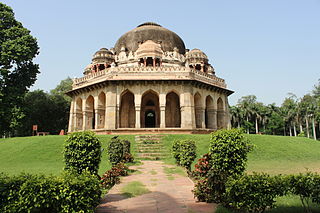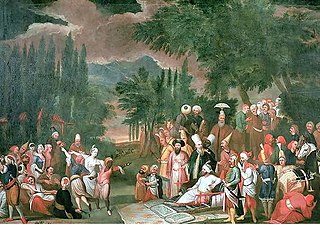
The Delhi Sultanate was an Islamic empire based in Delhi that stretched over large parts of the Indian subcontinent for 320 years (1206–1526). Five dynasties ruled over the Delhi Sultanate sequentially: the Mamluk dynasty (1206–90), the Khalji dynasty (1290–1320), the Tughlaq dynasty (1320–1414), the Sayyid dynasty (1414–51), and the Lodi dynasty (1451–1526). The sultanate is noted for being one of the few powers to repel attacks by the Mongols, causing the decline of Buddhism in East India and Bengal, and enthroning one of the few female rulers in Islamic history, Razia Sultana, who reigned from 1236 to 1240.

The Sayyid dynasty was the fourth dynasty of the Delhi Sultanate, with four rulers ruling from 1414 to 1451. Founded by Khizr Khan a former governor of Multan, they succeeded the Tughlaq dynasty and ruled the sultanate until they were displaced by the Lodi dynasty. Members of the dynasty derived their title, Sayyid, or the descendants of the Islamic prophet, Muhammad, based on the claim that they belonged to his lineage through his daughter Fatima, and son-in-law and cousin Ali.

The Chagatai Khanate or Chagatai Ulus was a Mongol and later Turkicized khanate that comprised the lands ruled by Chagatai Khan, second son of Genghis Khan, and his descendants and successors. At its height in the late 13th century, the khanate extended from the Amu Darya south of the Aral Sea to the Altai Mountains in the border of modern-day Mongolia and China, roughly corresponding to the defunct Qara Khitai Empire. Initially the rulers of the Chagatai Khanate recognized the supremacy of the Great Khan, but by the reign of Kublai Khan, Ghiyas-ud-din Baraq no longer obeyed the emperor's orders. During the mid-14th century, the Chagatais lost Transoxania to the Timurids. The reduced realm came to be known as Moghulistan, which lasted until the late 15th century when it broke off into the Yarkent Khanate and Turpan Khanate. In 1680, the remaining Chagatai domains lost their independence to the Dzungar Khanate, and in 1705, the last Chagatai khan was removed from power, ending the dynasty of Chagatai.

The Mamluk Dynasty was directed into Northern India by Qutb ud-Din Aibak, a Turkic Mamluk general from Central Asia. The Mamluk Dynasty ruled from 1206 to 1290; it was the first of five unrelated dynasties to rule as the Delhi Sultanate till 1526. Aibak's tenure as a Ghurid dynasty administrator lasted from 1192 to 1206, a period during which he led invasions into the Gangetic heartland of India and established control over some of the new areas.

Ghiyath al-Din Tughluq, Ghiasuddin Tughlaq, or Ghazi Malik, was the founder of the Tughluq dynasty in India, who reigned over the Sultanate of Delhi from 1320 to 1325. He founded the city of Tughluqabad. His reign was cut short after five years when he died under mysterious circumstances in 1325.
Hizabruddin, better known by his title Zafar Khan, was a general of the Delhi Sultanate ruler Alauddin Khalji. He held charge of Multan, Samana, and Sivistan at various times during Alauddin's reign and successfully defeated the [[Mongols].

Sayyid Khizr Khan ibn Malik Sulaiman was the founder of the Sayyid dynasty, the ruling dynasty of the Delhi sultanate, in northern India soon after the invasion of Timur and the fall of the Tughlaq dynasty.

The Malwa Sultanate was a late medieval kingdom presumably of Turkic origin, in the Malwa region of the present day Madhya Pradesh state in India in 1392–1562.
The Jaunpur Sultanate was an independent kingdom of northern India between 1394 and 1479, whose rulers ruled from Jaunpur in the present day state of Uttar Pradesh. The Jaunpur sultanate was ruled by the Sharqi dynasty. The Khwajah-i-Jahan Malik Sarwar, the first ruler of the dynasty was a wazir (minister) under Sultan Nasiruddin Muhammad Shah IV Tughluq (1390–1394). In 1394, he established himself as an independent ruler of Jaunpur and extended his authority over Awadh and a large part of the Ganges-Yamuna Doab. The dynasty founded by him was named so because of his title Malik-us-Sharq. The most acclaimed ruler of this dynasty was Ibrahim Shah.

Ma'bar Sultanate, unofficially known as the Madurai Sultanate, was a short lived independent kingdom based in the city of Madurai in Tamil Nadu, India. The sultanate was proclaimed in 1335 when the then viceroy of Madurai, Jalaluddin Ahsan Khan declared his independence from the Delhi Sultanate. Ahsan Khan and his descendants ruled Madurai and surrounding territories until 1378 when the last sultan, Ala-ud-Din Sikandar Shah fell in battle against the forces of the Vijayanagara Empire led by Kumara Kampana. In this short reign of 43 years, the Sultanate had 8 different rulers.

Kotla Mubarakpur Complex, a medieval village, is now an upscale market place with a residential colony in South central part of New Delhi. The village Kotla Mubarakpur dominates Bainsla gotra of Gurjars in India. Classified by the Delhi Development Authority (D.D.A.) as an Urban Village, it is situated within touch of South Extension-I. Its main road connected opposite with Defence Colony. Nearest Delhi Metro station is South Extension, INA metro station and Lajpat Nagar. Its history can be traced to the prominent tomb of Muizud Din Mubarak Shah, son of Khizr Khan of the Sayyid dynasty of the fifteenth century Delhi Sultanate rule in India, and its adjoining mosque. There are several other tombs of Lodi Dynasty period such as the Darya Khan's tomb, Kale Khan ka Gumbad, Bare Khan ka Gumbad, Chote Khan Ka Gumbad and Bhure Khan ka Gumbad, and also a Baoli.

Khusro Khan was a medieval Indian military leader, and ruler of Delhi as Sultan Nasiruddin Khusrau Shah for a short period of time.
Shibab-ud-din Omar (r. 1316) was the third Sultan of the Khalji Dynasty of Delhi Sultanate in India. After the death of his father Alauddin Khalji in 1316, he ascended the throne as a minor, with the support of Alauddin's slave-general Malik Kafur. After the assassination of Kafur, his brother Qutb-ud-din Mubarak became the regent, and subsequently dethroned him to become the Sultan.
Malik Dinar was a native Indian slave who served as general in Khalji Dynasty of Delhi Sultanate. He served as subordinate officer Malik Kafur and was also a Shihna-yi pil or intendant of elephantry and was sent by Kafur to suppress rebellion in Gujarat. His daughter has been married the third Khalji dynasty sultan, Qutb ud din Mubarak Shah. he was given the title 'Zafar Khan'(literally chief of victory). The very same title which bestowed to one of greatest Khalji military general who repelled the Chagatai Khanate repeated invasions into India, Zafar Khan Malik Hizbaruddin.
The following is a timeline of the history of Delhi, including New Delhi. Changes in ruling nation are in bold, with a flag to represent the country where available.

Mubarak Shah was the second monarch of the Sayyid dynasty which ruled the Delhi Sultanate. He succeeded his father, Khizr Khan to the throne. The Sayyids were subservient to Timur's successor, Shah Rukh, and while Khizr Khan did not assume the title of sultan, Mubarak Shah was acknowledged as one by Sirhindi. However, it is also known that Mubarak Shah received a robe and a chatr from the Timurid capital of Herat which indicates that the fealty continued in his time. He was murdered in 1434 and succeeded by his nephew, Muhammad Shah.

Muhammad Shah was the third monarch of the Sayyid dynasty which ruled the Delhi Sultanate. He succeeded his uncle, Mubarak Shah to the throne.. Both Muhammad Shah and his son, Alam Shah who succeeded him, were supplanted by the Lodi dynasty.
Yahya bin Ahmad Sirhindi was a 15th century Indian chronicler who wrote Tarikh-i-Mubarak Shahi, a Persian language chronicle of the Delhi Sultanate. Written during the reign of Mubarak Shah, his work is an important source of information for the Sayyid dynasty.
Jasrath Khokhar was the chief of the Khokhars during 1420–1442. He was known for ruling the Punjab region, Jammu, Haryana, Himachal Pradesh and parts of Khyber Pakhtunkhwa. His campaigns also included Delhi.










